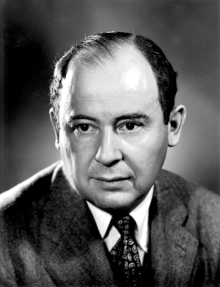
Back John von Neumann AN جون فون نيومان Arabic جون فون نيومان ARZ John von Neumann AST Con fon Neyman Azerbaijani جان فون نویمان AZB Джон фон Нейман Bashkir Džuons vuon Neimans BAT-SMG Джон фон Нейман Byelorussian Джон фон Нойман Bulgarian
John von Neumann | |
|---|---|
 von Neumann in the 1940s | |
| Member of the United States Atomic Energy Commission | |
| In office March 15, 1955 – February 8, 1957 | |
| President | Dwight D. Eisenhower |
| Preceded by | Eugene M. Zuckert |
| Succeeded by | John S. Graham |
| Personal details | |
| Born | Neumann János Lajos December 28, 1903 Budapest, Kingdom of Hungary |
| Died | February 8, 1957 (aged 53) Washington, D.C., U.S. |
| Resting place | Princeton Cemetery |
| Citizenship |
|
| Alma mater | |
| Known for | Mathematical formulation of quantum mechanics, Game theory, Spectral theory, Ergodic theory, von Neumann algebras, List of things named after John von Neumann |
| Spouses |
|
| Children | Marina von Neumann Whitman |
| Awards |
|
| Scientific career | |
| Fields | Logic, mathematics, mathematical physics, theoretical physics, statistics, economics, computer science, theoretical biology, chemistry, computing |
| Institutions | |
| Thesis | Az általános halmazelmélet axiomatikus felépítése (The axiomatic construction of general set theory) (1925) |
| Doctoral advisor | |
| Other academic advisors | |
| Doctoral students | |
| Other notable students | |
| Signature | |
John von Neumann (/vɒn ˈnɔɪmən/ von NOY-mən; Hungarian: Neumann János Lajos [ˈnɒjmɒn ˈjaːnoʃ ˈlɒjoʃ]; December 28, 1903 – February 8, 1957) was a Hungarian and American mathematician, physicist, computer scientist, engineer and polymath. He had perhaps the widest coverage of any mathematician of his time,[9] integrating pure and applied sciences and making major contributions to many fields, including mathematics, physics, economics, computing, and statistics. He was a pioneer in building the mathematical framework of quantum physics, in the development of functional analysis, and in game theory, introducing or codifying concepts including cellular automata, the universal constructor and the digital computer. His analysis of the structure of self-replication preceded the discovery of the structure of DNA.
During World War II, von Neumann worked on the Manhattan Project. He developed the mathematical models behind the explosive lenses used in the implosion-type nuclear weapon.[10] Before and after the war, he consulted for many organizations including the Office of Scientific Research and Development, the Army's Ballistic Research Laboratory, the Armed Forces Special Weapons Project and the Oak Ridge National Laboratory.[11] At the peak of his influence in the 1950s, he chaired a number of Defense Department committees including the Strategic Missile Evaluation Committee and the ICBM Scientific Advisory Committee. He was also a member of the influential Atomic Energy Commission in charge of all atomic energy development in the country. He played a key role alongside Bernard Schriever and Trevor Gardner in the design and development of the United States' first ICBM programs.[12] At that time he was considered the nation's foremost expert on nuclear weaponry and the leading defense scientist at the U.S. Department of Defense.
Von Neumann's contributions and intellectual ability drew praise from colleagues in physics, mathematics, and beyond. Accolades he received range from the Medal of Freedom to a crater on the Moon named in his honor.
- ^ Dyson 2012, p. 48.
- ^ Israel, Giorgio [in Italian]; Gasca, Ana Millan (2009). The World as a Mathematical Game: John von Neumann and Twentieth Century Science. Science Networks. Historical Studies. Vol. 38. Basel: Birkhäuser. p. 14. doi:10.1007/978-3-7643-9896-5. ISBN 978-3-7643-9896-5. OCLC 318641638.
- ^ Goldstine 1980, p. 169.
- ^ Halperin, Israel. "The Extraordinary Inspiration of John von Neumann". In Glimm, Impagliazzo & Singer (1990), p. 16.
- ^ While Israel Halperin's thesis advisor is often listed as Salomon Bochner, this may be because "Professors at the university direct doctoral theses but those at the Institute do not. Unaware of this, in 1934 I asked von Neumann if he would direct my doctoral thesis. He replied Yes."[4]
- ^ John von Neumann at the Mathematics Genealogy Project. Retrieved 2015-03-17.
- ^ Szanton 1992, p. 130.
- ^ Dempster, M. A. H. (February 2011). "Benoit B. Mandelbrot (1924–2010): a father of Quantitative Finance" (PDF). Quantitative Finance. 11 (2): 155–156. doi:10.1080/14697688.2011.552332. S2CID 154802171.
- ^ Rédei 1999, p. 7.
- ^ Macrae 1992.
- ^ Aspray 1990, p. 246.
- ^ Sheehan 2010.
© MMXXIII Rich X Search. We shall prevail. All rights reserved. Rich X Search